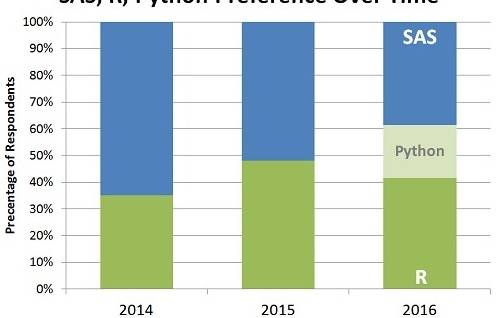blogger | Posted on |
Choosing between SAS, R and Python for Big Data Solution
0
1358 Views

Big Data Analytics has been implemented by all organizations that are looking for a higher growth trajectory, regardless of the size and nature of their company. There are three key data analytics tools, i.e. SAS, Python and R that are most generally chosen by organizations. As in all cases where there are varieties and competition, a comparative study is made between these three key platforms to get the best fit. We will now discuss a few points that may aid in opting for the most appropriate technology.
A Brief Background
SAS has been the unquestionable leader in commercial analytics and provides a broad range of statistical tools, great GUI, and immaculate technical support. It is not open source and therefore the most costly platform in the market, however it has the newest statistical functions to validate the price. R is an open source alternative to SAS and commonly holds ground in academics and research. It leverages its open source nature by making the newest techniques available very fast. It is a very economical option and there is wide documentation available online for anyone looking to master the platform. In R, there is a distinct advantage of advanced statistical features like for computationally exhaustive tasks, C, C++, and FORTRAN code can be related and called at run time. Some more progressive features can aid editing R objects directly. Python is another open source scripting programming language that has grown to include libraries and functions for most statistical processes and model building. With the advent of the Pandas, it has further reinforced its operations on structured data.
Finding the best fit
● For the cost-conscious: Being a commercial software, SAS is expensive. It has the highest inclination and rules the space where private enterprises are concerned. On the other hand, R and Python are free and can be downloaded by anybody seeking their services.
● From the learning perspective: If you have a working knowledge of SQL, then you can simply learn SAS, and even if you don’t have it, the platform has a steady GUI interface in its repository. It also has broad libraries and wide-ranging documentation that are obtainable in the websites of numerous universities. However, SAS training certification can be expensive. R is the hardest to master as you have to begin from learning and understanding coding, with extended codes for simple procedures. Lastly, Python is renowned for its ease and though there aren’t various GUI interfaces for the platform just now, it won’t be long before Python notebooks become more prevalent as they have excellent features for documentation and sharing.
● SAS has functional graphical competences that are basic and customization of plots is a complicated business. R possesses the best graphical capabilities with numerous packages. Python has choices to use derived libraries or native libraries, and is quite good, though while not quite a match for R, it is better than SAS.
● SAS is the market leader for jobs in corporates since most of the big companies work with the platform. R and Python are sought generally by startups for whom cost efficiency is supreme. The two open source platforms are observing a gradual increase in the market though.
All three systems come with a list of their own advantages and disadvantages. SAS is obviously the leading technology to work with for big data analysis, however knowledge of R and Python will aid as additional expertise.
